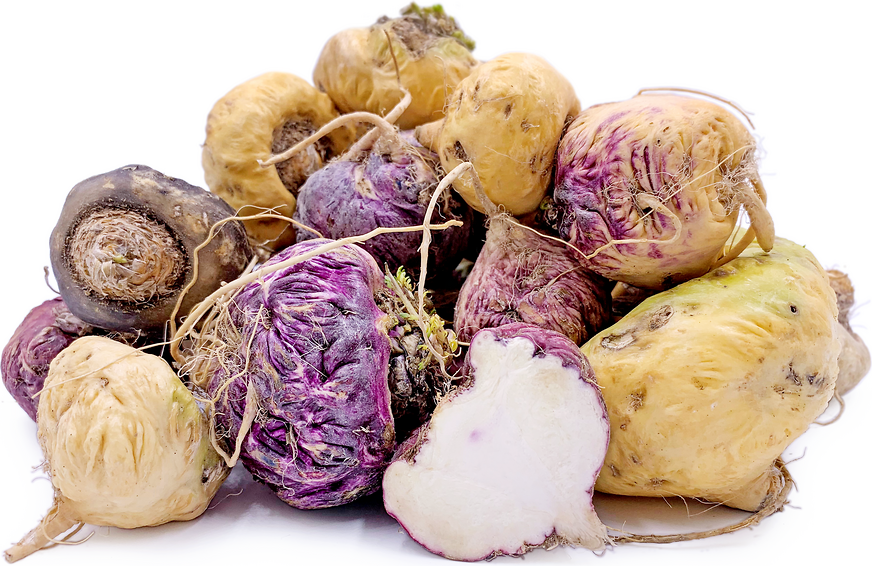


Maca Roots
Estimated Inventory, lb : 0
Description/Taste
Maca root is small in size, averaging 2-7 centimeters in diameter, and varies significantly in shape from spherical, ovate, triangular, to rectangular. Above ground, short and flattened green stalks grow up to twenty centimeters in length and are covered in lacy green leaves, forming small rosettes on top of the soil. Below ground, the stalks are connected to smooth cream-colored or yellow, black, and red roots that are firm, dense, and crunchy. When cooked, Maca roots have an earthy, nutty, and slightly sweet taste. The leaves are also edible and have a mild, green flavor.
Seasons/Availability
Maca root is available year-round.
Current Facts
Maca, botanically classified as Lepidium meyenii, is an herbaceous plant grown for its nutritious root and is a member of the Brassicaceae family along with cabbage, kale, and broccoli. Also known as Peruvian ginseng, Maca root is native to the Andes Mountains in Peru and is one of the few crops that is grown in high elevations reaching over four thousand meters above sea level. There are three main varieties of Maca, including black, yellow, and red, with the yellow being the most popular in the commercial market and black maca being labeled as the rarest. Within these three varieties, it is also believed that there are as many as forty different variations of red, black, and yellow maca, creating some roots that contain a blend of multiple colors. Maca root was once localized to Peru where it has been used as a medicinal aid and culinary ingredient for thousands of years, but it has recently seen an increase in popularity in the global market for its health benefits. Maca root can be found fresh in Peru and in dried form outside of Peru and is most commonly sold in powder form, as a liquid, or as a supplement.
Nutritional Value
Maca root is an excellent source of vitamin C, copper, iron, potassium, and vitamin B6. It also contains some manganese, fiber, magnesium, calcium, and zinc.
Applications
Maca root is said to be edible when raw, but it is strongly recommended to boil the root before consumption to reduce any possible adverse effects. In Peru, the root is commonly dried for extended use and then boiled before consumption to create a soft consistency. Maca root can be consumed as a juice, used as a flour for baking, or used as a nutritional powder that can be added to smoothies, lattes, oatmeal, and protein bars. The root can also be mashed, boiled, dried, and then mixed with milk to make a porridge known as mazamorra, roasted to enhance the nutty, sweet flavor, cooked and combined with other vegetables for soups, or used as a filling for empanadas. Dried, whole Maca roots will keep up to two years when stored in a cool and dry place. Maca root powder will keep up to one year at room temperature when stored in a cool, dry, and dark place and up to two years when stored in the freezer.
Ethnic/Cultural Info
In Peru, Maca roots have been used for over three thousand years as a medicinal remedy and in culinary preparations. Believed in providing energy to the body, improving stamina, increasing fertility, and protecting daily gland functioning, Peruvians consume Maca root frequently as a good source of nutrients. Maca root has also recently exploded in the global health food market, increasing the amount of Maca root powder exported from Peru. In the United States, Maca root is commonly found in powder or supplement form and is growing in popularity via social media platforms and health food bloggers sharing the root’s nutritional benefits. With this increase in exportation, Maca root has become a cash crop for Peru.
Geography/History
Maca root is native to Peru, specifically the central Andes mountains, and grows at an altitude of four-thousand meters above sea level. Cultivated since ancient times, Maca root grows in a harsh climate consisting of strong winds and extreme temperature fluctuations from freezing to the glaring sun. Today the root is still predominately grown in this region, with a few other countries such as China and the United States attempting to cultivate the root, but the harvests are small and difficult to achieve. Maca root can be found fresh at local markets in Peru, and in powder and supplement form in the United States, Asia, Central America, South America, Europe, and Australia.
Recipe Ideas
Recipes that include Maca Roots. One
| The Maca Team |
|
Maca Gingersnap No-Bake Treats |
| The Maca Team |
|
Maca Coconut Whip Strawberry Sundae |










